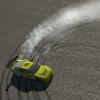Well if I abandon it and use the regular slipangle formula then there is alot more jerking. This is why I started using the SAE method.
Yes, much more, but should not be seen :) The wheels constantly get like (Fy) +1000N, -1000N, +1000N, -1000N ... and at the end of the simulation step they will remain at the same spot.
As for racer, this is the game that inspired me to do my own sim stuff back in the day and I have learned alot fro mracers old source, tho it has some pretty messy code, but its a pleasure t ostill have it online.
Me too, but unfortunately when it first came out around 2001, I didn't understand the first thing from it, I wasn't "smart" enough, physics wise. Reading the the "Physics of Racing Series", packed with funny units like, foot-pounds and slugs, didn't help too much either :D So I just dropped the topic..
And yeah I have been at the gropu but totally forgot it. Thanks for reminding it!
Lucky you, I haven't even head of it until maybe a year ago :)
Anyway, maybe you could help me too;
As I mentioned I'm rewriting the whole driveline and the torque transfer is not getting to work. Especially with inertias and accelerations.
What I achieved so far.
The whole driveline has 2 states: The clutch is locked or not.
1:
If locked, the output torque is calculated down to each wheels (only locked diff for now)
The wheels are accelerated with their inertia (not effective)
Based on the wheels angular velocity I calculate the engine speed.
The clutch has a maximum torque that it can transfer based on the pedal (clutch_factor)
If the torques going through the clutch exceed the maximum, it gets unlocked.
2:
The clutch is slipping, the output torque accelerates the flywheel with the effective inertia (engine to wheel)
Transfer the torque to the wheels and accelerate them with their self inertia as with locked clutch.
All the torques from engine and back from the wheels are clamped to the current max clutch torque (see above)
Also while the clutch is not locked both parts get the clutch torque to reduce the difference in angular velocities.
Once the velocity difference (engine/gearbox) switches sign, the clutch is locked again
Probably this is the method we all use, but:
Not sure where should I use effective inertias and where not, and which?
For example at the wheel
wheel_acc=(T_Drive+T_Road_reaction+T_Brake) / Inertia
this is the method that seems to work, but where is the inertia from the wheel to the engine
If I make it like:
acc=(T_Drive+T_Road_Reaction) / Inertia_engine_to_wheel;
anv_vel+=acc*dt;
acc=T_Brake / Inertia_wheel_to_engine;
ang_vel+=acc*dt;
It "sucks" big time, so to say... I have pain keeping the car on the road even moving straight.
Calculating the t_road_reaction with t_brake even worse.
I don't have a clue yet, just trying different variations hoping for any of them will work. 








